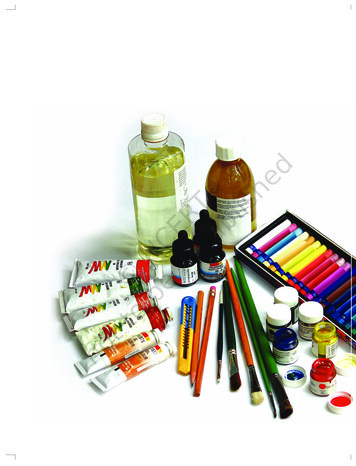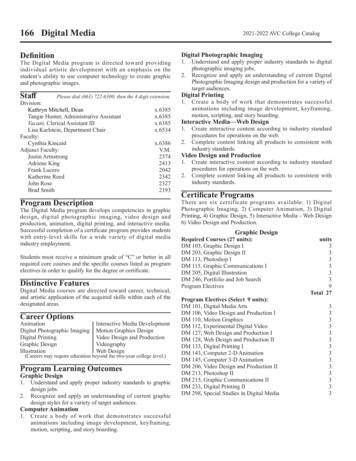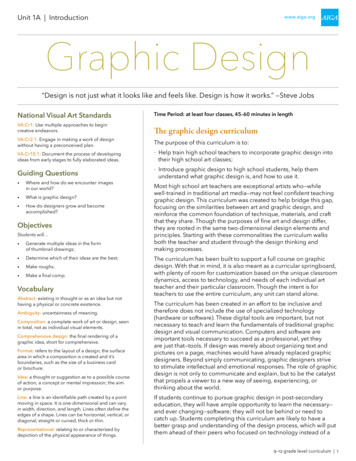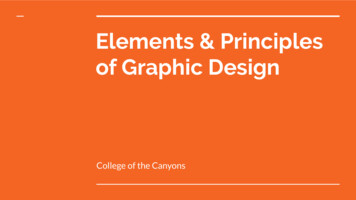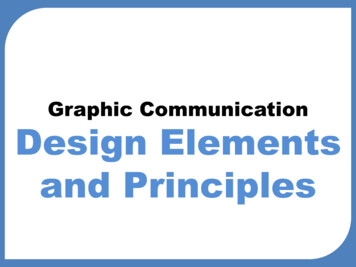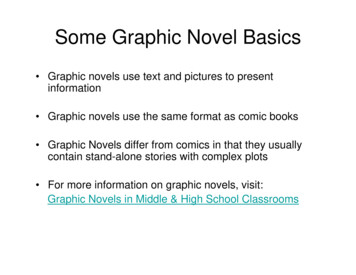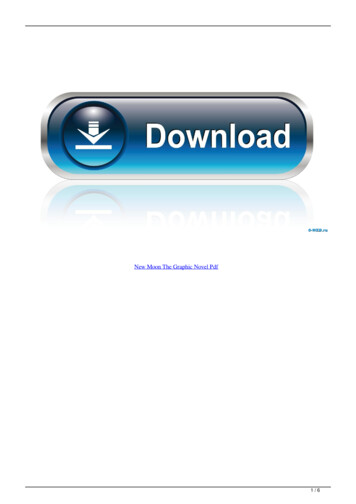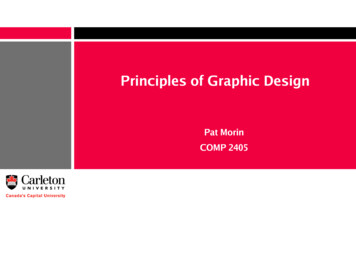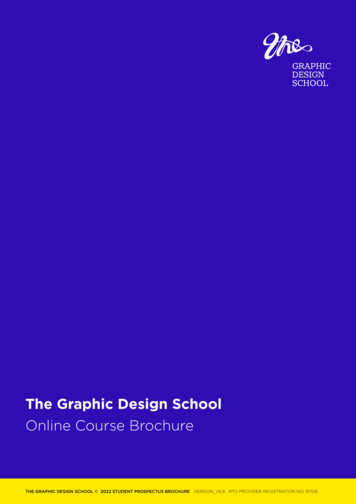
Transcription
Design elements graphic style manual pdf
Graphic design is the art and science of combining text and graphics to communicate an effective message in the design of websites, logos, graphics, brochures, newsletters, posters, signs, and other types of visual communication. Designers achieve their goals by combining the elements and principles of graphic design. Some concepts, such ascontrast, are both elements and principles: the former, as a visual characteristic; and the latter, as the technique by which it's employed. In addition to the obvious ones such as images and type, graphic design elements include lines, shapes, texture, value, size, and color. Graphic designers for print and web pages use some or all of these elements togenerate effective designs. The goal is usually to attract the viewers’ attention and, sometimes, to motivate them to take a specific action. Lines are the most basic of the design elements. Lines can be straight, curved, thick, thin, solid, or not solid. They are used to connect two points, separate sections of a design, and focus the user's eye. Theirqualities create emotion, movement, organization, and more. For example, a jagged line conveys emotion; a line that ends in an arrow forces the viewer's eye to look in a specific direction. A line that meanders among several elements guides the viewer from one element to the next and onward through the page. The basic geometric shapes aresquares, circles, and triangles. They form boxes or borders on a design or solid shapes for decorative purposes. Icons, symbols, and dingbats are also considered shapes, and they add interest and clarity. Certain graphics techniques, such as the use of rhythm and shadow, create texture—the visual "feel" of an element. Texture can serve as abackground, enhance overall appearance, and add character to other elements such as type and images. Lesley Shepherd Color attracts attention and conveys emotion and mood. For example, red represents strength, anger, or passion. Blue invokes peace, professionalism, or security. Value is a measure of darkness and lightness in an element ordesign. Value creates contrast and emphasis. For example, a light object against a dark background draws the viewer's eye. The size of an element in graphic design generally indicates its importance. The most important information is typically the largest on the page and draws the viewer's attention first. Most good graphic designs achieve visualbalance by using symmetrical, asymmetrical, or radial symmetry around a visual center. In symmetrical balance, both sides of a page layout are the same in weight, shape, lines, and other elements. Asymmetrical balance occurs when the two sides of a website aren't the same, but they have similar elements. Radial symmetry places elements in acircular pattern. Although it is popular in print layouts, radial symmetry isn't seen much on websites because the circular placements are difficult to achieve. Occasionally, a graphic designer intentionally produces an unbalanced design, usually to focus attention on a single element. In design, as in other areas, you need to know the rules before youcan break them effectively, but unbalanced designs can work. Alignment refers to lining up the elements of a design along the top, bottom, center, or sides of the elements. The aligned elements don't have to be of the same type. They are frequently aligned along the left edge of the layout. Different-size photos appear as a unit when they are alignedacross the top or the bottom. Repetition duplicates the characteristics of similar elements to contribute to design consistency. Repetition can also create rhythm in a design. A series of bulleted points of interest in the same color, type, and size appear as a complete unit. crispyicon / Getty Images Proximity maintains a relationship between items thatgo together. The elements don't have to be positioned closely together, but they should be connected visually. Contrast occurs with the juxtaposition of opposing elements: big versus small or dark versus light, for example. Contrast can highlight important elements of a design. Contrast is easily achieved with color, but it can also occur with texture,type, and graphic elements. Space is the part of a design that is left blank. Negative space is intentionally placed in the design. The margins and gutters between other elements are referred to as passive space. Space in a design adds emphasis to an area because the eye gravitates to the part of the design that is not empty. Effective graphic designtakes into account both positive and negative space. Thanks for letting us know! Tell us why! Want more? Advanced embedding details, examples, and help! Embed Size (px) 344 x 292429 x 357514 x 422599 x 487 SlideShare uses cookies to improve functionality and performance, and to provide you with relevant advertising. If you continue browsingthe site, you agree to the use of cookies on this website. See our User Agreement and Privacy Policy. SlideShare uses cookies to improve functionality and performance, and to provide you with relevant advertising. If you continue browsing the site, you agree to the use of cookies on this website. See our Privacy Policy and User Agreement for details.DESIGN ELEMENTS 001-025 40337.indd 1 001-025 C70319.indd 1 12/19/13 3:21 PM 1/14/14 4:51 PM TEXT (F39) Job:12-40337 Title:RP-Design Elements 2nd Edition 01-AC70319 #175 Dtp:160 Page:1 2014 by Rockport Publishers All rights reserved. No part of this book may be reproduced in any form without written permission of the copyrightowners. All images in this book have been reproduced with the knowledge and prior consent of the artists concerned, and no responsibility is accepted by producer, publisher, or printer for any infringement of copyright or otherwise, arising from the contents of this publication. Every effort has been made to ensure that credits accurately comply withinformation supplied. We apologize for any inaccuracies that may have occurred and will resolve inaccurate or missing information in a subsequent reprinting of the book. First published in the United States of America by Rockport Publishers, a member of Quayside Publishing Group 100 Cummings Center Suite 406-L Beverly, Massachusetts 019156101 Telephone: (978) 282-9590 Fax: (978) 283-2742 www.rockpub.com Visit RockPaperInk.com to share your opinions, creations, and passion for design. TI D E Originally found under the following Cataloging Samara, Timothy. Design elements : a graphic style manual : understanding the rules and knowing when to break them / Timothy Samara. p.cm. ISBN-13: 978-1-59253-261-2 (flexibind) ISBN-10: 1-59253-261-6 (flexibind) 1. Graphic design (Typography) 2. Layout (Printing) I. Title. Z246 .S225 686.2’2—dc22 2006019038 CIP ISBN: 978-1-59253-927-7 Digital edition published in 2014 eISBN: 978-1-62788-057-2 10 9 8 7 6 5 4 3 2 1 U r t Cover and text design Timothy Samara, New YorkPrinted in China 001-025 40337.indd 2 001-025 C70319.indd 2 12/19/13 3:21 PM 1/14/14 4:51 PM TEXT (F39) Job:12-40337 Title:RP-Design Elements 2nd Edition 01-AC70319 #175 Dtp:160 Page:2 001-025 C7 001-025 C7 9/13 3:21 PM 4/14 4:51 PM tion ge:2 TIMOTHY SAMARA DESIGN ELEMENTS Understanding the rules and knowing when tobreak them SECOND EDITION UPDATED EXPANDED 001-025 C70319.indd 3 001-025 C70319.indd 3 1/14/14 4:51 PM 1/14/14 4:51 PM TEXT (F39) Job:12-40337 Title:RP-Design Elements 2nd Edition 01-AC70319 #175 Dtp:160 Page:3 CONTE EN 26 86 128 186 FORM AND SPACE COLOR FUNDAMENTALS CHOOSING AND USING TYPE T WIM THE IDENTITY OF COLOR STRUCTURE AND OPTICS THE chapter 01 chapter 02 SEEING FORM AND SPACE CATEGORIES OF FORM 28 CHROMATIC INTERACTION 38 PUTTING STUFF INTO SPACE 88 58 COMPOSITIONAL STRATEGIES 72 COLOR SYSTEMS 98 112 EMOTIONS AND MESSAGES 122 chapter 03 130 ISSUES RELATED TOSTYLE MED 138 MECHANICS OF TEXT 146 PRE TEXTURE AND SPACE 162 CON TYPE AS INFORMATION 170 HOW COLOR AFFECTS TYPE 001-025 40337.indd 4 001-025 40337.indd 4 ch 182 12/19/13 3:21 PM 12/19/13 3:20 PM TEXT (F39) Job:12-40337 Title:RP-Design Elements 2nd Edition #175 Dtp:160 Page:4 001-025 403 001-025 403WHAT IS GRAPHIC DESIGN? 06 TWENTY RULES FOR MAKING GOOD DESIGN 10 CAUSIN’ SOME TROUBLE: WHEN AND WHY TO BREAK EVERY RULE IN THIS BOOK INDEX BY SUBJECT CONTRIBUTORS 296 312 318 E ENTS 186 232 THE WORLD OF IMAGE PUTTING IT ALL TOGETHER THE NATURE OF IMAGES MERGING TYPE ANDIMAGE chapter 04 MEDIA AND METHODS 188 204 chapter 05 WORKING WITH GRIDS tion ge:4 246 PRESENTATION OPTIONS 216 INTUITIVE ARRANGEMENT CONTENT AND CONCEPT 220 DESIGN AS A SYSTEM 001-025 40337.indd 5 001-025 40337.indd 5 264 272 THE WORKING PROCESS 9/13 3:21 PM 9/13 3:20 PM 234 288 12/19/133:21 PM 12/19/13 3:20 PM TEXT (F39) Job:12-40337 Title:RP-Design Elements 2nd Edition #175 Dtp:160 Page:5 A graphic designer is a communicator: someone who takes ideas and gives them visual form so that others can understand them. WHAT IS GRAPHIC DESIGN? Logo for a financial services company LSD SPAIN Logo for a food bankNAROSKA DESIGN GERMANY Branding and wayfinding for a wine merchant PARALLAX AUSTRALIA 06 07 001-025 C70319.indd 6 001-025 40337.indd 6 1/14/14 4:52 PM 12/19/13 3:20 PM TEXT (F39) Job:12-40337 Title:RP-Design Elements 2nd Edition 01-AC70319 #175 Dtp:160 Page:6 001-025 C7 001-025 C7 4/14 4:52 PM 9/13 3:20 PM tionge:6 Book cover with transparent jacket LABORATÓRIO SECRETO BRAZIL The designer uses imagery, symbols, type, color, and materials—whether printed or on-screen—to represent the ideas that must be conveyed; and to organize them into a unified experience that is intended to evoke a particular response. While more or less confined to thecreation of typefaces and books from the Middle Ages until the Industrial Revolution of the late 1700s and early 1800s, design expanded into advertising, periodicals, signage, posters, and ephemera with the appearance of a new, consumer marketplace. The term “graphic design” itself appeared more recently (attributed to W. A. Dwiggins, anAmerican illustrator and book designer, in 1922, to describe his particular activities). The formal study of design as an independent discipline didn’t come about until the 1920s, and the term entered into wide usage only after World War II. In contrast to other disciplines in the visual arts, graphic design’s purpose is typically defined by a client—it’s aservice paid for by a company or other organization—rather than generated from within the designer. Although artistic creation historically had been commissioned by patrons, it wasn’t until the 1830s that the mystique of the bohemian painter as “expresser of self ” arose and, consequently, a marked distinction between fine and commercial art.Designers encouraged this distinction for philosophical, as well as strategic, reasons, especially as they began to seek recognition for design as a profession that could add tremendous value to corporate endeavors. In the fifty-odd years since, the graphic designer has been touted as everything from visual strategist to cultural arbiter— and, since themid 1970s, as an “author” as well—shaping not only the corporate Invitation to a marketing event STUDIO NEWWORK UNITED STATES 07 design elements 001-025 C70319.indd 7 001-025 C70319.indd 7 1/14/14 4:52 PM 1/14/14 4:52 PM TEXT (F39) Job:12-40337 Title:RP-Design Elements 2nd Edition 01-AC70319 #175 Dtp:160 Page:7 Website foran architecture firm bottom line through clever visual manipulation of a brand-hungry public, but also the larger visual language of the postmodern environment. All these functions are important to graphic design . but, lest we forget the simplicity of the designer’s true nature, let us return to what a graphic designer does. A graphic designerassimilates verbal concepts and gives them form. This “giving form” is a discipline that integrates an enormous amount of knowledge and skill with intuition, creatively applied in different ways as the designer confronts the variables of each new project. To is an de a To to ed to m pe POULIN MORRIS UNITED STATES Further, a designer must bemore than casually familiar with psychology and history, both with respect to cultural narratives, symbolism, and ritualized experiences, as well as to more commercial, consumer-based impulses and responses (what is often referred to as marketing). Last, but certainly not least, a designer must have great facility with—and more often, in-depth,specialized knowledge of—multiple technologies needed to implement the designed solution: printing media and techniques, film and video, digital programming, industrial processes, architectural fabrication, and so on. D th pr PAU A designer must understand semiotics— the processes and relationships inherent in perception and interpretation ofmeaning through visual and verbal material. He or she must have expertise in the flow of information—instructional strategies, data representation, legibility and usability, cognitive ordering, and hierarchic problem solving—extending into typography, the mechanics of alphabet design, and reading. To design requires analytical and technical masteryof image making—how shapes, colors, and textures work to depict ideas, achieve aesthetic cohesion and dynamism and signify higher-order concepts while evoking a strong emotional response. Yal Animated motion sequence ONLAB GERMANY Broch 08 what is graphic design? 09 001-025 40337.indd 8 001-025 40337.indd 8 12/19/13 3:21 PM12/19/13 3:20 PM TEXT (F39) Job:12-40337 Title:RP-Design Elements 2nd Edition #175 Dtp:160 Page:8 001-025 403 001-025 403 To understand the meaning of design is.to understand the part form and content play.and to realize that design is also commentary, opinion, a point of view, and social responsibility. To design is much more thansimply to assemble, to order, or even to edit; it is to add value and meaning, to illuminate, to simplify, to clarify, to modify, to dignify, to dramatize, to persuade, and perhaps even to amuse. Design is both a verb and a noun. It is the beginning as well as the end, the process and product of imagination. PAUL RAND/GRAPHIC DESIGNER/ From his bookDesign, Form, and Chaos. Yale University Press: New Haven, 1993 But graphic design is greater than just the various aspects that comprise it. Together, they establish a totality of tangible, and often intangible, experiences. A designer is responsible for the intellectual and emotional vitality of the experience he or she visits upon the audience, and hisor her task is to elevate it above the banality of literal transmission or the confusing selfindulgent egoism of mere eye candy. And yet, beauty is a function, after all, of any relevant visual message. Just as prose can be dull or straightforward or well edited and lyrical, so too can a utilitarian object be designed to be more than just simply what it is. “Iffunction is important to the intellect,” writes respected Swiss designer Willi Kunz, in his book, Typography: Macro- and Micro-Aesthetics, “then form is important to the emotions . Our day-to-day life is enriched or degraded by our environment.” The focus of this book is on these formal, or visual, aspects of graphic design and, implicitly, theirrelevance for the messages to be created using them. It’s a kind of user manual for creating what is understood to be strong design, and empowering readers to effectively—and skillfully—harness their creativity to meet the challenges that a designer must meet every day. Brochure page spread for an energy company 09 9/13 3:21 PM 9/13 3:20 PMtion ge:8 COBRA NORWAY design elements 001-025 40337.indd 9 001-025 40337.indd 9 12/19/13 3:21 PM 12/19/13 3:20 PM TEXT (F39) Job:12-40337 Title:RP-Design Elements 2nd Edition #175 Dtp:160 Page:9 R b b ig TWENTY RULES FOR MAKING GOOD DESIGN DAV Fro the Lon Event poster SANG ZHANG/PARSONS SCHOOL OF DESIGNUNITED STATES 10 11 001-025 40337.indd 10 001-025 C70319.indd 10 12/19/13 3:21 PM 1/25/14 2:27 PM TEXT (F39) Job:12-40337 Title:RP-Design Elements 2nd Edition 01-AC70319 #175 Dtp:160 Page:10 001-025 403 001-025 C7 9/13 3:21 PM 5/14 2:27 PM tion e:10 ” Rules can be broken— but never ignored. DAVID JURY/ TYPOGRAPHER/From his book About Face: Reviving the Rules of Typography RotoVision, London, 1996. 11 When people talk about “good” or “bad” design, they’re referring to notions of quality that they’ve picked up from education and experience, and often from the experience of thousands of designers and critics before them. Sometimes, these notions areaesthetic—“asymmetry is more beautiful than symmetry,” for example, or “a neutral typeface is all you need”— and sometimes strictly functional—for example, “don’t reverse a serif typeface from a solid background if it’s less than 10 points in size, because it’ll fill in.” Both kinds of observation are helpful in avoiding pitfalls and striving to achievedesign solutions that aren’t hampered by irritating difficulties—to make every design be all that it can be. Every time an attempt is made to cite rules governing what constitutes quality, however, people are bound to get their underwear in a knot: “That’s so limiting!” To those people, I’ll say this: get over it. Rules exist—especially the ones set forthhere—as guidelines, based on accumulated experience from many sources. As such, rules always come with exceptions and can be broken at any time, but not without a consequence. The consequence of breaking one rule might mean reinforcing another, and it might mean true innovation, in the right context—a context in which a revelation occursthat, oddly enough, will establish yet another rule. This is how human creativity works. The importance of knowing which rules are considered important (at least historically), and why, is understanding the possible consequences of breaking them so that something unfortunate doesn’t happen out of ignorance. In addition, rules act as guides inhelping to build a communal discussion about interpreting and evaluating creative work. If everything is “good,” then nothing really can be. Relativism is great, to a point, and then it just gets in the way of honest judgment; the result is a celebration of ubiquitous mediocrity. By no means should any rule, including those that follow, be taken as cosmiclaw. If you’re unconvinced, simply turn to page 296, where breaking every rule in this book is advocated wholeheartedly. But these rules are a starting point, an excellent list of issues to consider while you work. In the end, you will decide how and when to apply the rules, or not, as well as understand the results of either course of action. designelements 001-025 40337.indd 11 001-025 C70319.indd 11 12/19/13 3:21 PM 1/25/14 2:27 PM TEXT (F39) Job:12-40337 Title:RP-Design Elements 2nd Edition 01-AC70319 #175 Dtp:160 Page:11 01 0 HAVE A CONCEPT. If there’s no message, no story, no idea, no narrative, or no useful experience to be had, it’s not graphic design. It doesn’t matterhow amazing the thing is to look at; without a clear message, it’s an empty, although beautiful, shell. That’s about as complicated as this rule can get. Let’s move on. CO DO Zippered plastic bags with evidence stickers package the books in a series of detective novels. The books themselves become artifacts of the crime novels. THOMAS CSANOCANADA This website for a digital illustration studio foregoes conventional presentation in favor of an appropriately image-based environment designed to evoke the workspace of a medieval scribe— tasked with illuminating manuscripts. The studio’s work is presented within the pages of an open book, with navigation appearing as a set of softwareprogram tools at upper left. DISTURBANCE SOUTH AFRICA 12 twenty rules for making good design 001-025 40337.indd 12 001-025 40337.indd 12 0 BE A ve are mea Sure it, b do s upo and bou idea on t 13 12/19/13 3:21 PM 12/19/13 3:20 PM TEXT Ooo carr abst give It’s effe ute eye Kno why (F39) Job:12-40337 Title:RP-Design Elements 2ndEdition #175 Dtp:160 Page:12 001-025 403 001-025 403 02 COMMUNICATE— DON’T DECORATE. he e es me ADA y — Oooh . Neat! But what exactly is it? Form carries meaning, no matter how simple or abstract, and form that’s not right for a given message junks it up and confuses. It’s great to experiment with images and effects, but anythingthat doesn’t contribute to the composition or meaning is simply eye candy that no longer qualifies as design. Know what each visual element does and why, or choose another with purpose. The notion of “blooming” underpins a publication of graduating students’ design work; unique abstract ink washes create the sense of 03 unfurling flower petalswithout being literal. TIMOTHY SAMARA UNITED STATES One of the reasons you like this poster so much is that it speaks to our common knowledge so clearly; it feels almost as if it hasn’t been designed. A hot-colored circle floating over a cool blue horizon and punctuated by a refreshing yellow field pretty much explains itself. ADAMSMORIOKAUNITED STATES BE UNIVERSAL. he h ols A very large audience, not a few people who are “in the know,” must interpet what you mean with those shapes, colors, and images. Sure, you get it, and other designers will get it, but ultimately it’s the public who must do so. Speak to the world at large; draw upon humanity’s shared narratives of form andmetaphor and make connections, not boundaries. If you’re unsure whether your ideas make sense, show them to someone on the street and find out. 13 9/13 3:21 PM 9/13 3:20 PM tion e:12 design elements 001-025 40337.indd 13 001-025 40337.indd 13 12/19/13 3:21 PM 12/19/13 3:20 PM TEXT (F39) Job:12-40337 Title:RP-Design Elements 2ndEdition #175 Dtp:160 Page:13 04 In this set of exhibition collateral, a specific visual language of silhouetted images—all similarly geometric in their shapes, monochromatically colored, and transparent— responds to the type’s symmetrical axis with a rhythmic left-to-right positioning. Stroke contrast and graphic details in the serif type unify with theimagery’s ornate internal details, while contrasting with its planar quality. SPEAK WITH ONE VISUAL VOICE. 0 GOLDEN COSMOS GERMANY Make sure all the elements “talk” to each other. Good design assumes the visual language of a piece—its internal logic— is resolved so that its parts all reinforce each other, not only in shape or weight orplacement, but conceptually as well. When one element seems out of place or unrelated, it disconnects from the totality and the message is weakened. 05 Exquisite, decisive control of the minimal elements, alignments, and the spaces around and between them creates a dynamic, almost architectural space that is active and threedimensional . whichis all you really need for a brochure for a contemporary architecture firm. LSD SPAIN IF YOU CAN DO IT WITH LESS, THEN DO IT. This is a riff on the “less is more” theory, not so much an aesthetic dogma now as it is a bit of common sense: the more stuff jammed into a given space, the harder it is to see what needs to be seen. There’s a bigdifference between “complicated” and “complex.” True power lies in creativity applied to very little—without sacrificing a rich experience. Adding more than needed is just “gilding the lily.” 14 twenty rules for making good design 001-025 40337.indd 14 001-025 40337.indd 14 15 12/19/13 3:21 PM 12/19/13 3:20 PM TEXT (F39) Job:12-40337Title:RP-Design Elements 2nd Edition #175 Dtp:160 Page:14 001-025 403 001-025 403 atage r y mic roke s al 06 CREATE SPACE — DON’T FILL IT. Negative (or white) space is critical to good design. It calls attention to content and gives the eyes a resting place. Negative space is just as much a shape in a layout as any other thing. Carve it out andrelate it to other elements. A lack of negative space overwhelms an audience, and the result is an oppressive presentation that no one will want to deal with. From within a confined space enclosed by the visual angles creatd by headline and body text, hands stretch outward to release a symbolic butterfly; the image’s message is restated subtly by thecompositional space with which it interacts. LOEWY UNITED KINGDOM of nnd ural eeyou or re 15 9/13 3:21 PM 9/13 3:20 PM tion e:14 design elements 001-025 40337.indd 15 001-025 40337.indd 15 12/19/13 3:21 PM 12/19/13 3:20 PM TEXT (F39) Job:12-40337 Title:RP-Design Elements 2nd Edition #175 Dtp:160 Page:15 07 Viewers are likely tosee this theater poster’s title treatment from thirty strides away, followed by the theater’s name and, in a sequence of decreasing contrast, weight, and size, the rest of the information. These type treatments, along with the movement creatd by the title and the supporting shapes, help move the viewer’s eyes from most important item to leastimportant. DESIGN RUDI MEYER GIVE ’EM THE ONE-TWO PUNCH. FRANCE 0 Focus viewers’ attention on one important thing first—a big shape, a startling image or type treatment, or a daring color— and then lead them to the less important items in a logical way. This is establishing a “hierarchy”—the order in which you want them to look at thematerial—and it is essential for access and understanding. Without it, you’ve already lost the battle. 08 BEWARE OF SYMMETRY. As in nature, symmetry can be quite effective, but approach it with extreme caution. Symmetrical layouts easily become static and flat, and they severely limit flexibility in arranging content that doesn’t quite fit thesymmetrical mold. Symmetry also is often perceived as traditional (not always relevant) and may suggest the designer is lazy and uninventive—as though the format has directed how the material will be arranged. While the designers of this book, which organizes text and headings relative to both the vertical and horizontal center 16 axes of thepages, retained the appropriate gravitas needed for its academic subject, they nonetheless also counteracted its potentially static quality A str divis (from with nal r and c sizes the e through the use of extreme scale contrast, transparency, and rotation of text elements. STUDIO BLUE UNITED STATES twenty rules for making good design 001025 C70319.indd 16 001-025 40337.indd 16 17 1/14/14 4:53 PM 12/19/13 3:20 PM TEXT (F39) Job:12-40337 Title:RP-Design Elements 2nd Edition 01-AC70319 #175 Dtp:160 Page:16 001-025 C7 001-025 403 s ent ame sing the se h the le help m st YER 4/14 4:53 PM 9/13 3:20 PM tion e:16 09 A strong progression of spatial divisions across thispage spread (from wide to narrow), together with carefully arranged diagonal relationships among forms and continual contrast in the sizes, values, and proximities of the elements achieves dramatic 17 FIGHT THE FLATNESS. People make a weird assumption about two-dimensional visual stuff, and that is: it’s flat! Go figure. Layouts that fail toimpart a sense of depth or movement— those in which everything is the same size, weight, color, and perceived distance from everything else—are dull and lifeless. “Without contrast,” Paul Rand once said, “you’re dead.” Fool the viewer into seeing deep space by exploiting changes in size and transparency. Create differences in density and opennessby clustering some elements and pushing others apart. Apply color to forms such that some appear to advance and others recede. Convince the viewer that the surface is a window into a bigger, engaging world. optical movement and contributes to the perception of varied spatial depths. STAYNICE NETHERLANDS design elements 001025 C70319.indd 17 001-025 40337.indd 17 1/14/14 4:53 PM 12/19/13 3:20 PM TEXT (F39) Job:12-40337 Title:RP-Design Elements 2nd Edition 01-AC70319 #175 Dtp:160 Page:17 10 PICK COLORS ON PURPOSE. Don’t just grab some colors from out of the air. Know what the colors will do when you combine them and, more important, what theymight mean to the audience. Color carries an abundance of psychological and emotional meaning, and this meaning can vary tremendously between cultural groups and even individuals. Color affects visual hierarchy, the legibility of type, and how people make connections between disparate items—sometimes called “color coding”—so choose wisely.Never assume that a certain color, or a combination of colors, is right for a particular job because of convention, either. Blue for financial services, for example, is the standout color cliché of the past fifty years. Choose the right colors, not those that are expected. The muted rose tones in this fragrance packaging are feminine without being girlish; aslight shift toward brown in the typography creates a subtle, yet rich, interaction. The complementary green-gold—almost a direct complement, but again, slightly off—presents rich contrast and hints at complexity and allure. A10 DESIGN BRAZIL 1 LE Colo man valu gett sim A lo for i colo mak 1 MA AN Ton sure Furt rang firec area exp of d tran dist18 twenty rules for making good design 001-025 C70319.indd 18 001-025 40337.indd 18 19 1/14/14 4:53 PM 12/19/13 3:20 PM TEXT (F39) Job:12-40337 Title:RP-Design Elements 2nd Edition 01-AC70319 #175 Dtp:160 Page:18 001-025 403 001-025 C7 or me se lor . s mia n the e, yet lest a in, conty 11 LESS COLOR IS MORE. Color is exciting but,much like a circus, too many things happening at once with hue, value, and intensity prevents viewers from getting a memorable color idea. Stick to a simple palette and create rich relationships. A lot can be accomplished with black alone, for instance; and using a single dramatic color, rather than black, is a sure way of making a big impact. IL 4/144:53 PM 9/13 3:20 PM tion e:18 The designer of this brochure spread, despite incorporating full-color photographic images, constrained the color palette to a set of closely related, cool 12 greens, blues, and violets, with warm tones used only for supporting elements. TIEN-MIN LIAO UNITED STATES Soft, rippling transitions from deep black toluminous blue provide a sensuous backdrop for the bright, sparkling typography in this poster. By changing the sizes of type clusters, as well as the spaces between th
Design elements graphic style manual pdf. Graphic design is the art and science of combining text and graphics to communicate an effective message in the design of websites, logos, graphics, brochures, newsletters, posters, signs, and other types of visual communication. Designers achieve their goals by combining the elements and principles of .
